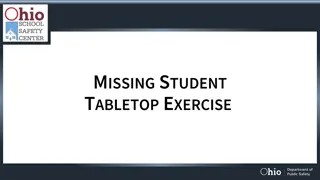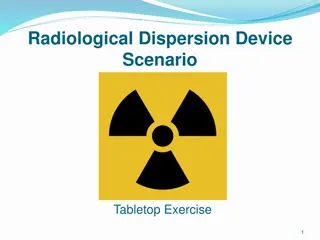Armed Intruder Tabletop Exercise - Preparedness and Coordination
Enhance preparedness for armed intruder situations in schools through a tabletop exercise focusing on testing response plans, coordination with partners, and identifying areas for improvement. The exercise aims to strengthen relationships with response partners and improve emergency communication strategies with parents and the community.
Download Presentation

Please find below an Image/Link to download the presentation.
The content on the website is provided AS IS for your information and personal use only. It may not be sold, licensed, or shared on other websites without obtaining consent from the author. Download presentation by click this link. If you encounter any issues during the download, it is possible that the publisher has removed the file from their server.
E N D
Presentation Transcript
Armed Intruder Tabletop Exercise
Exercise Agenda Welcome and Introductions Housekeeping Exercise Overview Goals Rules Objectives/Core Capabilities Assumptions and Artificialities Roles and Responsibilities Schedule Structure Scenario-Driven Exercise Facilitated Discussion in Four Modules Hot Wash Closing Comments Debrief
Welcome and Introductions Opening Remarks Facilitator Introductions Hosting Agency Participants Exercise Staff Lead Facilitator
Exercise Goals Test plans to prepare for, respond to, and recover from an armed intruder in our school. Ensure effective coordination of plans and actions with school and community partners. Strengthen relationships with our response partners. Identify areas for improvement and develop a corrective action plan.
Objectives and Core Capabilities To demonstrate the activation and use of the emergency notification system and Incident Command Structure. Identify additional school mitigation and preparedness needs. To further identify and test Emergency Operations Plans. To coordinate with local law enforcement. To enhance communications with parents and the community.
Participants Roles and Responsibilities Players: Respond to the situation presented, based on expert knowledge of response procedures, current plans and procedures, and insights derived from training. Facilitator(s): Responsible for moderating and keeping participant discussions focused on exercise objectives and core capabilities, and ensuring relevant issues are explored; provide situational updates and additional information; resolve questions as required.
Exercise Structure A scenario-driven, facilitated discussion-based exercise The exercise is divided in four modules: oModule 1: Initial Response Scenario Background oModule 2: Response Scenario Update #1 oModule 3: Response Scenario Update #2 oModule 4: Recovery Scenario Update #3 Debrief
Rules for Players There are no right or wrong answers/ideas. Varying viewpoints are expected and will be respected. Exercise decisions are not precedent setting. Players are encouraged to consider different approaches and suggest improvements/ Think outside the box.
Ground Rules This is not a test of current capabilities and plans. It is a discussion of probable responses to a hypothetical emergency. The exercise will be an open dialogue. All ideas and input are welcome. One person speaks at a time. The scenario will be accepted as is. However, the facilitator may make modifications as deemed appropriate. No hypothetical resources are available.
Assumptions and Artificialities The exercise is conducted in a no-fault learning environment wherein capabilities, plans, systems and processes will be evaluated. Participants respond to the TTX scenario events and other exercise information from the perspective of their school s current policies, plans, processes and capabilities. The exercise scenario is plausible, and events occur as they are presented in the TTX scenario, allowing for artificialities. All players receive information at the same time.
Exercise Schedule Exercise Logistics and Set-up Registration Welcome and Introductions Exercise Overview Module 1: Initial Response Scenario Background Break Module 2: Response Module 3: Scenario Update Module 4: Recovery Break Hot Wash Closing Comments Debrief
Tabletop Processes A scenario and update statements will be used to generate discussion of probable response actions. Participants will provide situational responses based on established procedures and plans. The Emergency Operations Plan (should be) available for reference. Other than maps and diagrams, no additional materials will be provided. The exercise will conclude with development of action steps needed to support future mitigation and preparedness efforts.
Exercise Guidelines Respond based on your knowledge of your school plans and capabilities. Discuss and present multiple options and possible solutions. Be aware that each phase will not have complete resolution. Any issues that cannot be resolved within a reasonable period of time will be tabled as an after-action item. If more information is needed, ask. Assume any agencies that are requested are initiating their response plans.
Module 1 Initial Response: Scenario Background
Date: Time: It s a crisp fall morning and students are entering the school. As the students walk the halls shouting is heard from the far end of the hallway. A student is noticed pushing through the bus entrance, moving swiftly through the crowd. As the morning bell rings she walks directly into the main office, closes the door and produces a handgun. She immediately fires a shot into the wall, narrowly missing the Vice Principal.
Scenario Background The student begins to cry and pace in front of the door. She is a 13 year old 8thgrader who has recently been recognized by a teacher as exhibiting behavioral changes. She has been identified for making suicidal references on social media due to recent conflict in her home life. There are three staff members and one student in the office with her and they have hidden behind desks and chairs, but are still very visible to her.
Most students and teachers have scrambled into classrooms and some have run outside. A nearby administrator has found a location adjacent to the office and has made a telephone call to the local police department.
Discussion Based on the information that you have, what specific response actions do you choose to take? Why? Based on the response action chosen what are your concerns? How will you communicate with your school community about the on going situation? What guidance will you give them on how to respond to this on going situation? For what contingencies must you plan? Given the situation who is designated as the Incident Commander? Why?
Module 2: Response
Date: Time: Three officers have responded to the school and are trying to establish communication with the student in the main office. A perimeter has been established by the police. EMS and Fire have also responded to the school, and tactical units are enroute.
Discussion With the information provided do your response actions change? If you have decided to evacuate other portions of the school not impacted by this incident where would people go, and how would they get there? Who is in charge of collaborating with emergency first responders arriving on the scene? Have we discussed in the past equipment or communication devices that can be used in a situation like this? What is the school s social media policy during a situation like this?
Module 3: Response - Scenario Update
Date: Time: Additional officers continue to respond to the scene. A perimeter has been established around the school. You are also being informed that a large number of parents are arriving at the scene as well. A call from the main office is received by the police department and the caller says that the student wishes to speak with her parents. You are informed by law enforcement that this incident may take a considerable amount of time to resolve.
Discussion In the past have you had a conversation with emergency first responders about where to assemble in a situation like this? Have you thought about establishing a unified command? If so, who would be included in that command? What planning have you done to ensure that your teachers, faculty, staff and students are prepared to deal with a potential incident like this? Do you feel confident that all classrooms and areas where students and staff may be located during a lockdown, have the appropriate locking mechanisms, and emergency response action guides that may direct them in managing an incident like this?
Module 4: Recovery
The police were able to take the student into custody without further incident. Several faculty and staff members that were in the office at the time of the incident are experiencing significant levels of trauma and are in need of medical attention
The media has been airing live feed from outside the school, interrupting regularly scheduled programming. The school is now receiving constant telephone calls from parents trying to find out about their children. Parents have started to arrive at the school and are upset that the police will not allow them to get past the established perimeter to talk to school personnel or find their children.
Discussion Who is the person who has been designated to talk to the media about this incident? Has this person ever received training in crisis communication? Will you coordinate your communications with the local law enforcement agency? Why or why not? How do you plan to communicate with your school community about this incident?
Discussion Describe the media platforms that will be utilized for this messaging? Now that the incident is over, do you plan to continue with the school day? If yes, why? If no, why not? Does your plan include how you will handle internal and external communications? How will the school triage the emotional needs of the students?
Hotwash Have you trained in options based response protocols? Did this exercise increase your awareness of school preparedness needs? How? Will this exercise provide input for continued emergency operations planning? How? What action steps should this group take now? What are the major lessons learned from today s discussion? What are tentative next steps to continue the discussion and address any areas of concern?
Where do we go from here? Specific Issues Identified Person assigned to follow-up Timeline of completion 3, 6, 9 months
Contact the Vermont School Safety Center Web Site Vermont School Safety Center Web Site Twitter https://twitter.com/vted_safeschool
Stay Connected With Us @margolishealy www.facebook.com/margolishealy www.linkedin.com/company/margolis-healy-&-associates























